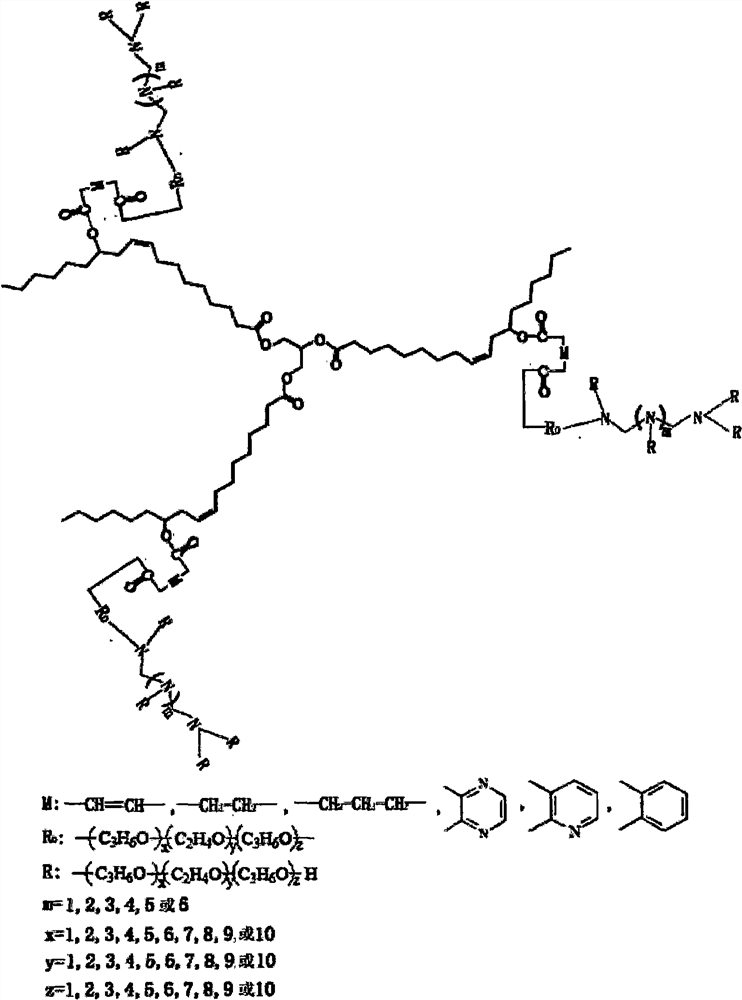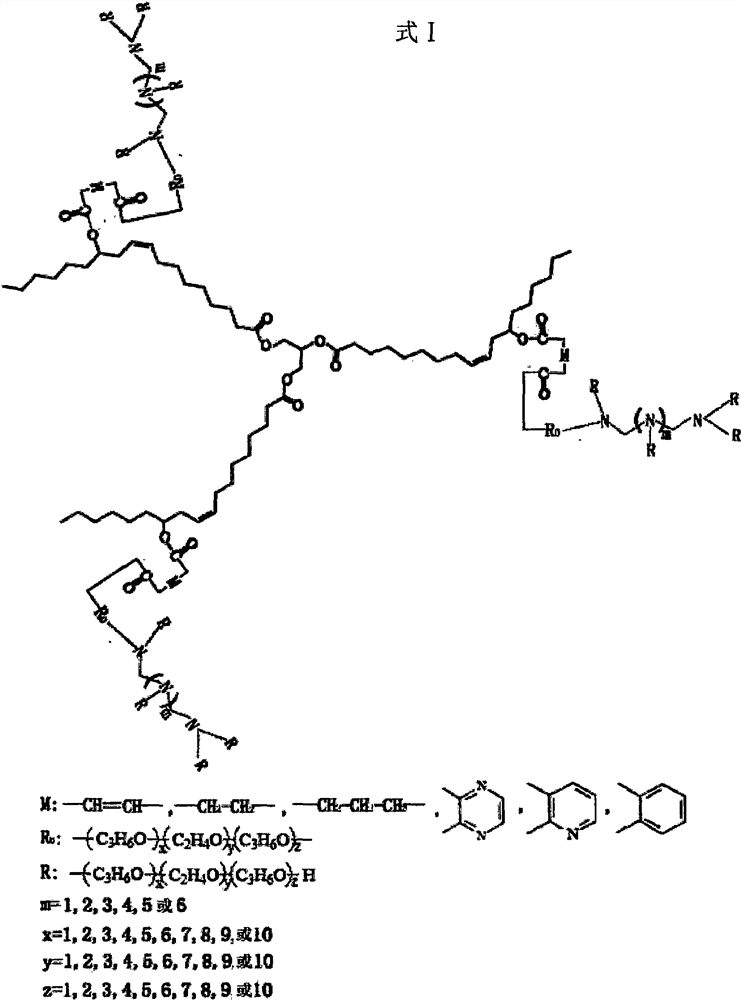Demulsifier for oil-water transition layer rich in polymers and colloid asphaltene in crude oil dehydration system and preparation method of oil-water transition layer demulsifying agent
A crude oil dehydration and demulsifier technology, applied in the direction of chemical dehydration/demulsification, etc., can solve problems such as excessive water content of oil products, disorder of dehydration system, environmental pollution, etc., and achieve safe use, flexibility and good wettability. , the effect of easy availability of raw materials
- Summary
- Abstract
- Description
- Claims
- Application Information
AI Technical Summary
Problems solved by technology
Method used
Image
Examples
Embodiment approach 1
[0043] 1. Preparation of Oil Head YPAE1
[0044]According to the mass ratio, tetraethylenepentamine: propylene oxide = 1: 199, first put a specified amount of tetraethylenepentamine into the reactor, heat up to 88-90°C, use nitrogen to bubble from the bottom of the reactor for 1 hour and measure Water content, and then measure the water content every half an hour until the water content is less than 0.03%, vacuumize, when the pressure in the reactor is -0.09~-0.08MPa, first introduce tetraethylene five-thirds of the mass of epoxy Propane, then raise the temperature to 99~105℃, keep the reaction pressure at 0.4~0.5MPa, when the pressure drops to 0.02MPa, then feed the remaining amount of propylene oxide, the reaction pressure is 0.4~0.5MPa, and the reaction temperature is 125~ 135°C, when the pressure drops to 0.02MPa, keep it warm for half an hour, and then cool down to 80°C to get YPAE1 oil head.
[0045] 2. Preparation of Demulsifier DPAE1
[0046] According to the mass ra...
Embodiment approach 2
[0059] 1. Preparation of Oil Head YPAE2
[0060] According to the mass ratio, mannitol: propylene oxide=1: 299, first put the prescribed amount of mannitol into the reactor, heat up to 88-90°C, use nitrogen to bubble from the bottom of the reactor for 1 hour and measure the water content, and then Bubble for half an hour to measure the water content, until the water content is less than 0.03%, vacuumize, when the pressure in the reactor is -0.09~-0.08MPa, first pass propylene oxide with one-third of the mass of mannitol, and then heat up to 99 ~ 105°C, keep the reaction pressure at 0.4 ~ 0.5MPa, when the pressure drops to 0.02MPa, then feed the remaining amount of propylene oxide, the reaction pressure is 0.4 ~ 0.5MPa, the reaction temperature is 125 ~ 135°C, when the pressure drops When it reaches 0.02MPa, keep it warm for half an hour, then cool down to 80°C to get YPAE2 oil head.
[0061] 2. Preparation of demulsifier DPAE2
[0062] According to the mass ratio, YPAE2: eth...
Embodiment approach 3
[0075] 1. Preparation of oil head YPAE3
[0076] According to the mass ratio, ethyl hydrogen-containing silicone oil: propylene oxide = 1:399, first put a specified amount of ethyl hydrogen-containing silicone oil into the reactor, raise the temperature to 88-90°C, and bubble nitrogen from the bottom of the reactor for 1 hour And measure the water content, and then measure the water content every half an hour until the water content is less than 0.03%, vacuumize, when the pressure in the reactor is -0.09~-0.08MPa, first pass one-third of the mass of ethyl hydrogen-containing silicone oil One propylene oxide, then heat up to 99-105°C, keep the reaction pressure at 0.4-0.5MPa, when the pressure drops to 0.02MPa, then feed the remaining amount of propylene oxide, the pressure should be 0.4-0.5MPa, the reaction The temperature is 125-135°C. When the pressure drops to 0.02MPa, keep the heat for half an hour, and then lower the temperature to 80°C to obtain the YPAE3 oil head.
[0...
PUM
| Property | Measurement | Unit |
|---|---|---|
| iodine value | aaaaa | aaaaa |
| density | aaaaa | aaaaa |
| density | aaaaa | aaaaa |
Abstract
Description
Claims
Application Information
 Login to View More
Login to View More - R&D
- Intellectual Property
- Life Sciences
- Materials
- Tech Scout
- Unparalleled Data Quality
- Higher Quality Content
- 60% Fewer Hallucinations
Browse by: Latest US Patents, China's latest patents, Technical Efficacy Thesaurus, Application Domain, Technology Topic, Popular Technical Reports.
© 2025 PatSnap. All rights reserved.Legal|Privacy policy|Modern Slavery Act Transparency Statement|Sitemap|About US| Contact US: help@patsnap.com



